eISSN: 2469-2794


Review Article Volume 9 Issue 2
University Nottingham Trent, UK
Correspondence: Andrew O’Hagan, University Nottingham Trent, Uk
Received: July 20, 2021 | Published: August 19, 2021
Citation: O’Hagan A, Edmundson CJ. County lines: The exploitation of vulnerable members of society. Forensic Res Criminol Int J. 2021;9(2):47-57. DOI: 10.15406/frcij.2021.09.00340
The transport of class A drugs from a urban centre to a coastal or rural location, where a profitable drug market has been identified, is known as county lines. A network of dedicated mobile phone lines are used to coordinate these operations. Through these processes, criminal groups are able to transition into nationwide organisations, moving drugs across one or more police boundary in order to maximise profit. These groups exploit vulnerable people, including children, to move drugs into identified areas, often taking control of their houses. This is achieved using intimidation, coercion and extreme violence. Activities of county lines groups have a highly detrimental effect on vulnerable people and the local communities in which they operate. Criminally exploited individuals are at high risk of drug addiction, sexual abuse and criminal conviction. The recent upsurge in UK crime coincides with the rise in numbers of county line groups since their emergence in 2015. The way that these groups do not hesitate to use extreme violence to intimidate individuals has led to an increase in knife crime and a high number of drug related homicides over the past year. It is vital that vulnerable individuals are safeguarded and that time is taken to identify those at risk. Intervention at an early stage can prevent gang recruitment, exploitation and serious injury or trauma.
Keywords urban street gangs, serious and organised crime, phone lines, gang roles, organised crime groups, heroin, cocaine, crack, exploitation, trafficking, safe guarding
In 2015 the National Crime Agency(NCA) first identified county lines as a ‘criminal business model’. Their sub sequent published report aimed to raise awareness of these activities to front line practitioners.1 County lines is the term used to describe the transport of class A drugs from an urban city to a county town where a profitable drugs market has been identified.2,3 This has been achieved by using multiple mobile phone lines, known as ‘deal lines’. Once established in a new community, various illicit drugs are promoted via the use of social media.3 The criminals involved in these groups often use coercion, intimidation, violence, sexual violence and weapons to target children and vulnerable adults who will then move and store drugs and money.4 County lines and the associated criminal activities have a devastating effect on the targeted group and also the local communities in which they operate. Many crimes continue to be linked to these criminal groups and organised street gangs, with the involvement of violence being common. Victims of violence can often be involved in the operation at the front end of the drugs supply. More than 3000 line numbers (phone lines) were identified across the UK in 2019, with 800 to 1100 lines estimated to be active during a given month.5 This type of crime enables criminal groups to transition from a local small scale operation into a nationwide organisation, expanding their drugs market from an urban centre to a coastal or rural area and transporting drugs across one or more police boundaries. This increases sales, in order to maximise profit.
The activities of such criminals have become a growing issue in the UK. Data from 2018-19shows that there had been an increase in the number of known lines, increasing from 720 inthe2017-18 assessment,6 to 3000 in 20195 Individual lines can generate profits of an estimated £800,000 per year and has resulted in a £500 million industry being created.7 The effect of the rapid increase in the size and volume of these groups has had a profound effect on communities and society, both socially and economically. The way in which they operate in the shadows, evading law enforcement agencies, coupled with the lack of knowledge from both the public and the police has allowed them to grow rapidly year on year. As a result, certain safeguarding organizations have surfaced in order to educate and deter people from joining these groups.3 However, these safeguarding organizations are not yet wide spread to all regions in which the criminal groups operate. The use of social media and multiple mobile phone lines has allowed organized crime groups to go undetected by law enforcement and become a major problem for police forces a cross the UK.
This report aims to explain the process and structure of county lines and highlight the crime increase that has been observed alongside its emergence. The various types of people who are targeted for exploitation will be discussed and an evaluation of the different approaches being used to tackle the work of these criminal organizations will be carried out.
Involvement in serious and organized crime
Serious and organized crime (SOC), as defined in the 2018 Serious and Organized Crime Strategy by the NCA, is when individuals plan, coordinate and commit serious offences, either as individuals, as part of a group and/or part of a transnational network.5 It affects all parts of the country and affects more UK citizens than any other national security threat. It continues to grow in size and has dramatically impacted the lives of individuals, communities, public services and institutions.8 It is a major issue in the UK and consumes a huge amount of police time. The NCA sets out a National Strategic Assessment (NSA) of serious and organized crime each year, the latest being published in April 2020. This assessment highlights the major threats in the UK, placing them into three categories; Firstly, exploitation of the vulnerable covering Child Sexual Abuse (CSA), Modern Slavery and Human trafficking (MSHT) and Organized Immigration Crime (OIC). Secondly, communities and violence focusing on drugs, firearms and Organised Acquisitive Crime(OAC).Thirdly, harm to the UK’s economy and institutions looking into cyber crime, fraud, money laundering, bribery, corruption and sanctions evasion.5
As previously out lined above, the victims of violence relating to county lines are often involved in the operation at the frontend of drugs supply. More than 3000 line numbers were identified across the UK in 2019, with 800 to 1100 lines estimated to be active during a given month.5 The threat from SOC continues to become more complex. As new technology is exploited, criminals are better able to communicate, commit and hide their crimes from law enforcement, with all current NCA investing actions encountering some sort of encryption.5 These of creating a profile with a fake name on social media provides an anonymous platform for criminals to lurk in the shadows and commit crimes whilst going undetected. County lines groups carry out most of their recruitment of drug traffickers and complete drug deals using social media.
There are now 4772 known organized crime groups (OCGs) in the UK, with one quarter of these groups estimated to be involved in violent criminal activity, and over 350,000 people estimated to be involved in organized crime.5 The continual increase in these numbers coincides with the increase in other factors such as violent crime and the growth in county lines groups.
Cases of serious violence are commonly linked to drugs. Within homicide cases, one third of victims and two thirds of suspects are either drug users or involved in the supply of drugs.5 Often cases of serious violence involving drugs are down to turf wars between opposing county line groups, but also due to the way that these groups take control of vulnerable individuals by intimidation and coercion. These individuals are used by organized gangs in the storage and distribution of drugs and money. Drug related homicides have increased by 11% from the financial year 2008/09 to financial year 2018/19; when 313 drug related homicides were recorded.5 Drug related violence is most prevalent with in the retail level. Which is mainly associated with urban street gangs(USGs). When the emergence of county lines was first identified by the NCA in 2015, USGs were one of the focus points. A gang being defined as a group of relatively durable, predominantly street-based young people who:
With in all gangs there are different roles carried out by different members. A ‘hierarchy of respect’ is followed,3 and members gain‘ respect’ based on the different tasks they carry out and whether or not they are efficient at certain roles. For example, someone who is good at selling drugs will gain ‘respect’ and move up the hierarchy. Some typical roles in county lines drug gangs have been given slang terms and Table 1 below defines these roles. Other roles include stores, retailers and buyers.3
|
County lines gang member roles and slang |
||||
|
Gangster girls |
Young females who adopt male personas. |
|||
|
Wifey/bae |
A young female who is in are cognized relationship with a gang |
|||
|
member. |
||||
|
Baby mamas |
Young females who have babies with gang members. |
|||
|
Link, bitch, sket, |
Young females who are associated with a gang through casual sex |
|||
|
ho, skank |
With gang members. They are seen and treated as disposable. |
|||
|
Elders |
The most senior members of the gang, these people are not seen on |
|||
|
The street and their name may not be known to all gang members. |
||||
|
Youngers |
Young males under the age of 18 who are dealers and recruiters |
|||
|
Underneath the elders. |
||||
|
Runners |
Young males aged 12 to 15 who deal and move drugs. |
|||
|
Teenies |
Young males under the age of 10 who are used to transport drugs. |
|||
|
Clean skins |
Young people who have not got a criminal record. |
|||
Table 1 Roles and slang names given to members in gangs explained3
Ending Gang and Youth Violence (EGYV) is a programme created by the home office aiming to firstly prevent youths from joining gangs, secondly to provide exit route for those wanting to leave gangs and finally to determine appropriate enforcement tactics and responses for dealing with those in gangs.10 There are 33EGYV areas in England and Wales. Within these areas drug supply has been reported as the main criminal activity. Other reported crimes include violent crime (including sexual violence), robbery, drug production and exploitation. County lines groups exploit many vulnerable people in order to spread their drug market from urban centers to rural areas of the country, so it is no surprise to see an increase in reports of exploitation in these areas.9
In 2017 an NCA threat assessment stated that 35 out of 44 police forces had encountered knife crime associated with county lines. By 2019 police in England and Wales had recorded the highest number of knife offences since records began. 45,627 offences involving knives or sharp instruments were recorded, an increase of 49% since 2011 and a 7% increase year on year.11 Turf, or gang territory, wars between competing county lines operations were observed and believed to be a significant factor in the rise in violence in rural areas.12 From the year ending March 2017 to March 2019,a quarter of homicide victims were known drug users, with 13% being known drug dealers. With the numbers being even higher in identified suspects 42% of suspects were users and 24%weredealers, and in all cases these numbers were higher in males than in females.13 Over the last decade the proportion of homicides related to drugs has increased from 36% in 2009to 47% in 2019. Last year alone there were 313 homicides where drugs were involved in some way, whether that be users, dealers or just related to drugs.13 From 2017-2019, the most common method of killing was by sharp instruments including knives. Data analyzed over the last decade shows that homicides due to sharp instruments rises and falls between 35%and 40%, with 259 homicides due to sharp instruments being recorded in the year ending March 2019.13 Figure 1 shows the most commons method of killing in homicide offences, with sharp instruments leading the way.
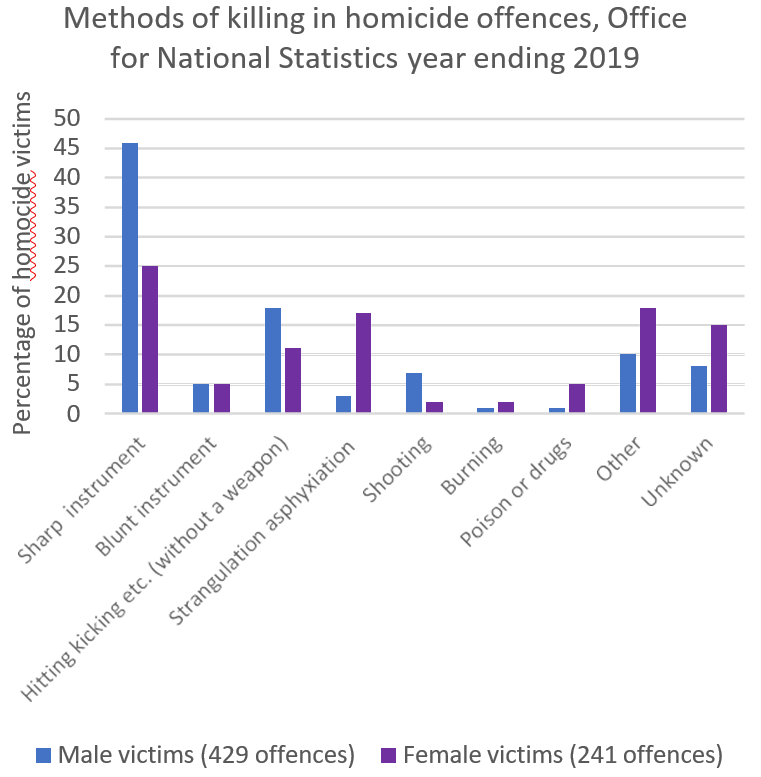
Figure 1 Bar chart showing the most common methods of killing in the year ending March 2019, recreated on office using data from.13
In December 2018 the NCLCC reported that Crack cocaine and heroin accounted for 69% of drugs supplied by branded lines.14 Figure 2 shows the types of drugs that county lines groups supplied across the UK in 2018, using data in office acquired from.14 Throughout the UK the demand for all common and illicit drug types remains high with the figures for drug related deaths continuing to increase. The latest available figures state that in 2018 drug related deaths increased by 19% across the UK with 5735 deaths recorded relating to drugs. An increase of 16% was observed in England and Wales alone, with 4359 drug related deaths being reported.5 The majority of OCGs in the UK involved in the supply of controlled drugs provide multiple types. One fifth of gangs are involved in the supply of heroin, cocaine and cannabis and these three drugs make up 72% of drug criminality in the UK.5 Deaths from heroin or morphine poisoning have doubled since 2012, with deaths from cocaine poisoning increasing by four and a half times since 2011.12
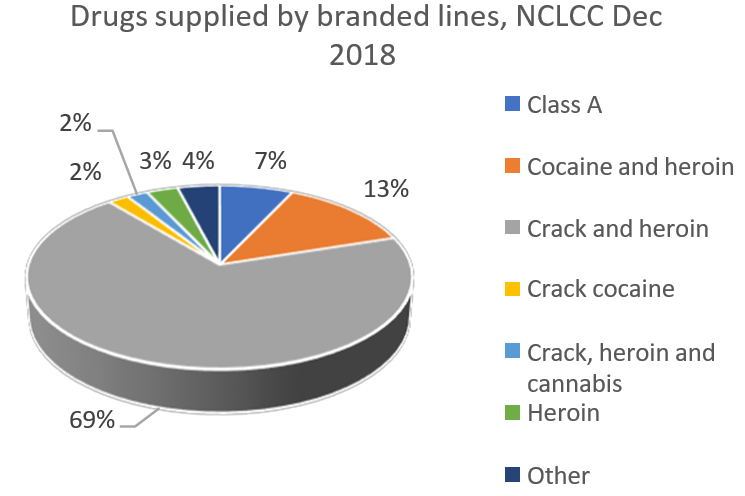
Figure 2 Pie chart which represents the types of drugs supplied by county lines groups, recreated on office using data from.14
Cocaine
Cocaine is a class A drug in the UK. At street level it is sold as a fine white powder with the majority of its production coming from Colombia, Peru and Bolivia. It is extracted from the coca plant by carrying out a systematic chemical process using the leaves of the plant. This process involves soaking the leaves in kerosene or petrol,15 and the resulting paste is mixed with concentrated hydrochloric acid and other harmful chemicals to form a fine powder.
There are various ways in which cocaine can being tested. It is typically snorted forcefully up the nose and this is known as “snorting”15 and can cause serious damage to then as all area. Repeated use causes the user to develop a tolerance, dependency and withdrawal symptoms if they stop using the drug.16 The use of cocaine causes the user to feel a short but quick euphoric high. This high is often followed by a massive low feeling and so the user will seek out more cocaine to combat this. The feeling felt by taking cocaine is caused by do pa mine stimulation in the brain which is triggered by taking the drug. This gives the user agree at feeling of euphoria and so encourages further usage.16
Annually the cocaine market in England, Scotland and Wales is worth between £9.4 billion and £11.8 billion. Consumption of the drug is believed to be up to 117 tones per annum, an increase of 290% on figures recorded from 2011.5 In 2018, it was reported that cocaine purity across Europe was currently at its highest level within the last decade, with an average purity of 73%.17 Data presented in 2020 stated that the average purity of analyzed cocaine samples had dropped slightly to 69%, with one in every two samples containing more than75% cocaine.18
Crack cocaine
Another form of cocaine is known as “crack”. It has intense stimulant properties and produces similar effects to the powder form. Although the effects are usually more intense. Crack is a rock form of the drug, most commonly smoked through a glass pipe. This is known as “free basing”.19 The drug vapors move quickly from the lungs into the blood stream and the high can be felt within seconds. This feeling usually lasts around 5-10 minutes and the short time frame in which a user feels the high is what appeals to them.19 The number of people dependent on the drug in the UK rose by 8.5% from 2011-2017,20 and the number of people seeking treatment for problems relating to crack cocaine rose by 44% in the years 2017-2018.21 Figure 3 shows the difference in appearance of Crack and powder cocaine.
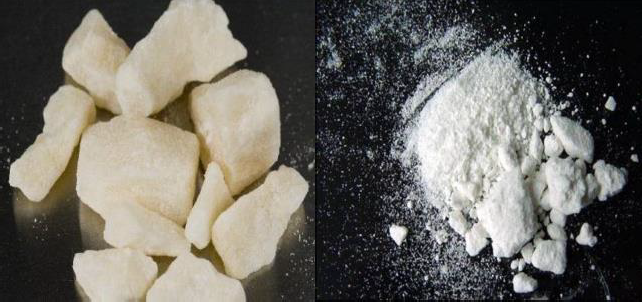
Figure 3 Image showing the difference in appearance between crack(left) and powder cocaine(right).22
Heroin
Purity levels for heroin are at a 10 year high.5 It is an opioid based drug, produced from morphine which is a naturally occurring substance found in the seed pod of opium poppy plants.23 The drug is either smoked known as “chasing the dragon”, or injected known as “shooting up”. It is highly addictive with users often becoming addicted after just one use.15
The most common form of heroin in the UK is impure heroin. This substance is dissolved and injected into a vein in order to enter the blood stream. Heroin is not water soluble and so has to be mixed with a weak acid such as vinegar.15 The first time a person uses heroin, a feeling of relaxation and peace is felt. However, once addicted the person struggles to achieve this again and will use vast amounts of the drug trying to repeat this same feeling. Heroin enters the brain quickly binding to opioid receptors which control the feelings of pain and pleasure.23 People often use crack cocaine and heroin together, this is extremely dangerous and is known as “speed balling”. It is administered by the use of a hypodermic syringe in very much the same way as in the preparation of heroin.22 Figure 4 below shows the preparation of Heroin via the use of a syringe.

Figure 4 Image showing the preparation of impure heroin before injection via the use of a hypodermic syringe.22
Cocaine production has increased in Columbia, as has heroin production in Afghanistan.24 Higher purity levels coincide with a higher production rate. Elevated drug production in these countries means that purity levels of the drugs at street level are increased. Dealers do not have to dilute the product with cutting agents to sell the same amount of product, when higher quantities of the drug are available. The high purity, coupled with extensive consumption of the drug, helps to ex plain why street drugs are contributing to an increase in deaths by poisoning.
County lines groups are contributing to the increase in consumption of these drugs by making them easier to obtain. As previously mentioned, the use of a complex network of mobile phone ‘deal lines’ is essential to the running of these operations. According to Public Health England and Home Office reports, respondents reported that dealers would use mobile phones containing the numbers of all local heroin and crack users to send out a generic message to the addicts. These messages would detail the latest special offers, advertising ‘deals of the day’ and containing certain buzzwords like ‘ happy hour’ and ‘power’.20 This tactic is used to activate the users desire to use the drug again, triggering their cravings and pushing them towards purchasing more drugs.20 This is a form of slick marketing by drug dealers and is in line with the increase in online sales of all merchandise, such as Amazon products.
As previously discussed, county lines operations expand their drugs market from an urban centre to a coastal or rural area, transporting (trafficking) controlled drugs across one or more police boundaries to sell in order to make a maximum profit. In 2015 an NCA report stated that USGs were becoming more structured and their crimes more organized. Senior members of gangs started to recruit younger members and deployed them to rural locations to expand their operations for higher profit. The concept behind it is for large gangs to expand drug selling operations from large cities such as Liverpool, London and Manchester into rural and coastal areas to increase the sale of drugs.2 Expansion of these operations and the related violence shows a shift in the modus operandi (MO) of gangs. Profit through drug selling has provided a new focus and as a result has seen a decline in the significance of defending postcodes and physical territory.12 Defending post codes refers to the fight for control of a certain area or neighborhood.
Figure 5 shows the top ten county towns that have been infiltrated by county lines groups from London. Over 4000 young people from London have been coerced or groomed into drug trafficking activity, travelling 69 miles on average to access the top ten towns.25 A message detailing which drugs are available is sent out to groups who are known to be interested in buying controlled drugs. The message is then relayed onto dealers in the rural and coastal areas using a separate mobile phone ‘line’.2 Vulnerable people, including children under the age of 18,are then exploited to transport these drugs from the major cities into the rural areas. Once delivered, another phone line is then used to contact the local addicts advertising what drugs the dealers have to offer. It is this complex network of mobile phone lines that makes these groups so hard to track.

Figure 5 Image showing the drug trafficking routes to the top ten county towns with county lines links to London. Image recreate do office using data from.25
Senior members within county lines groups often use high levels of violence to intimidate, coerce and control those involved. These tactics commonly involve the use of knives, weapons, firearms and even sexual exploitation/assault.26 Young people are often targeted to be employed as the ‘runners’. Senior members identify young adolescents who they believe will make a good drug dealer and exploit them at case due to socioeconomic disadvantage.27 Glamorous aspects of their lifestyle, such as high end cars, designer clothes and jewellery are conveyed on social media. Young people, often from poor backgrounds, are attracted to this lifestyle and idolise gang members. They desire to be like them and want to make money fast, which is exploited by gangs.27
The exploitation of vulnerable people in order to achieve the transportation and sale of drugs is common in the UK. Frequently targeted groups are young children, women and local users. Children between 15-17 form the majority of vulnerable people involved in county lines. Factors affecting the vulnerability of children include poverty, family breakdown, social care intervention, frequent missing episodes, behavioral and development disorders and exclusion from main stream schooling.6
Vulnerability factors affecting adults often include drug addiction and mental health problems.6
Children
Exploitation of young people is a common factor in county lines gang operations. The young often fall victim to the offer of a lavish lifestyle and lookup to senior members of gangs, making them easy to recruit. In a report by the NCA in 2016, 80% of areas surveyed witnessed the exploitation of children by gangs.28 Gang members use social media and schools to track potential recruits and initiate contact. Once a suitable child has been chosen the gang will exploit the musing coercion, deception, threats/intimidation, violence, debt bondage and grooming.28 Those targeted include those at pupil referral units, special education needs centres and in care homes.29
Once within the gang network, children will often be trapped in a highly exploitative situation working long hours with little reward.28 Children who have learning difficulties, disabilities, mental health issues, substance use problems or are experiencing family breakdown and trauma, are at an additional risk of being exposed to gang activity. Familial impact of gang activity is a strong factor in gang involvement. Children have reported becoming involved in gangs due to older siblings or parents being associated with a USG. Other reasons reported by children are peer pressure, protection due to their post code or a perception that the lifestyle associated with being in a gang comes with wealth and high status within ‘the streets’.30
Evidence from police forces suggests that young people will often fall victim and be targeted by members of their own gang. Senior members will steal drugs and money from their own runners in order to establish a debt, the debt will then be used as a method to further coerce and control the individual.30 Establishing a drug debt with young people involved in the gang is advantageous to senior gang members. It provides a stage for them to intimidate and subject the young person to violence. Being involved with gangs exposes these children to violence from a young age. This together with the fear of rival gangs and the risk of being caught by the police, make for a very traumatic experience for a young person. Putting them at risk of developing serious mental health problems thus preventing them from reaching their potential.30
Caucasian children are most commonly used. They are cheap to employ, easy to control and less detectable by police.3 These children are then shown how to, or made to, insert and carry the drugs in their vagina or rectum. Often using a condom, latex gloves or a balloon to conceal the drugs. Wrapped drugs can also be stored in their cheeks, which can be easily swallowed if they are approached by police.29 They travel via rail network, hire car, bus, coach and taxis to the rural location.28 Once they have arrived they are given various modes of transport, such as a bicycle, along with a mobile phone with a contact list of the known drug users pre-loaded. They are given targets to hit for drug sales and will reside at the ‘cuckooed’ properties of vulnerable adults also being exploited by the gang. Further risk is posed from these vulnerable adults who have their own issues such as battles with mental health and substance misuse; there has been instances where harm has been caused to children by these individuals.29
Adults
Adults are often targeted and chosen using similar factors to those in children. These factors include those who are addicts themselves, have mental health issues or have disabilities. Addicts are exploited easily as it is simple to establish a debt bondage due to their heavy drug usage. As discussed above, once this debt bondage is established between the user and the dealer/gang, it plays into the hand of the latter and gives them an excuse to further coerce, intimidate and control the person.30 For example,“ you owe me X amount of money, so you are going to help me move Y amount of drugs”.
Male adults are often subject to physical violence. Women have been reported to be less likely subjects of extreme violence than their male counterparts, but are more likely to suffer sexual exploitation.3 It is used as a means of control and can lead to criminal compliance. Typically the sexual exploitation will go unrecognized as the girls look up to the gang members due to feelings of protection, financial stability and of a higher social status which they have not felt before.3 Other reports have evidenced that females are also prostituted to other gang members, for monetary gain. Sex can also be used to settle drug debts between either the female and gang members or between rival gangs. One report stated that a group of gang members filmed a sexual assault carried out by multiple gang members, the film then being used to humiliate the male partner of the victim.26 This is just one of the many examples of how sexual exploitation is used to control individuals.
County line groups often take control of the home of a vulnerable adult through coercion and violence to intimidate the individual. They will then use this house for the storage of drugs and cash, and this is known as ‘cuckooing’. However, there has recently been an increase in the use of short term lets and guest houses rather than cuckooed properties.6 The term comes from the way in which the cuckoo bird takes over the nests of other birds, for its young, instead of building its own. Victims of cuckooing are often extremely vulnerable and so do not report what has happened to the police through fear of the gang.3
County lines allows criminal groups, or gangs, to increase the profits through drug sales whilst also decreasing their chance of being caught by the police.27 Exploitation of vulnerable people, having them sell drugs from their own homes on behalf of more powerful gang members from major cities, means that the criminals involved at a more senior level of the county lines gangs can remain hidden to both law enforcement and rival gangs. Consequently, if the representatives in the rural location are arrested, the gang can cut ties and relocate at ease. Similarly, if the runners miss payment, lose product or have it stolen then the gang can easily impose itself upon said runner and them and payment.27
Figure 6 shows how people of different vulnerabilities are exploited by gangs. Data should best studied when planning a multi-agency approach to tackling county lines gangs and their recruitment of vulnerable people.
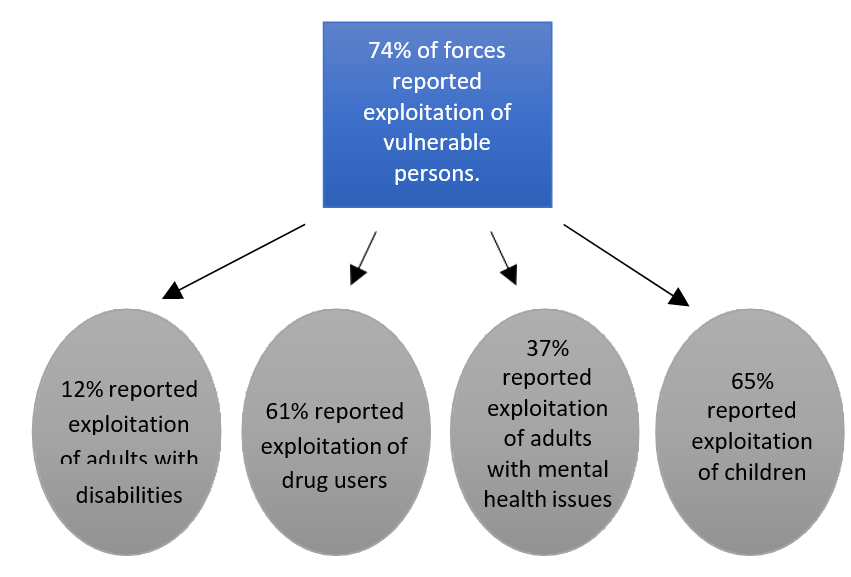
Figure 6 data highlighting the different groups of vulnerable people who are exploited by county lines gangs across police borders in the UK. Data obtained from.26
Undersection2.1ofthislaw, trafficking is defined as when “the person arranges or facilitates the travel of another person (“V”) with a view to V being exploited”. Section 3 goes onto describe exploitation as when “another person uses or attempts to use the person (a) to provide services of any kind, (b) to provide another person with benefits of any kind, or (c) to enable another person to acquire benefits of any kind”.31
The Anti-Slavery Commissioner, Kevin Hyland, recently stated in a report into the policing response to MSHT that using and exploiting vulnerable and young people in county lines operations for the transport and sale of controlled drugs was a type of “modern-days la very”.27 In April 2018 two gang members involved in carrying out a county lines operation were convicted of human trafficking offences after they forced a 19 year old woman to transport drugs from London to Swansea. This case was thought to be the first in UK legal history where police have used powers under the Modern Slavery Act 2015 to prosecute gang members relating to county lines and the sale of class A drugs.32 This means that police now have the potential to prosecute criminals involved in these operations under the Modern Slavery Act 2015.
It is clear that these offences can be applied directly to county line drug gangs and how they operate. A key feature of these operations is the use of children and vulnerable people to do the ‘dirty work’ for the senior members, transporting, storing and selling drugs. Being able to prosecute gang members under this act, and increasing awareness of this law through multi agency support may increase the number of vulnerable people and children coming forward to report these offences.27 A case study from South Wales police gave one example of how a female had been used by a London gang to sexually gratify its members and was victim to sexual violence due to drug debts. She was twice the victim of attempted kidnap, as well as being trafficked to London to pay off a debt through the means of prostitution.33
In July 2019, 16 gang members were jailed for transporting and selling class A drugs relating to a county lines operation in the south east of England. The arrests followed a joint investigation from the Metropolitan Police and Kent Police.34 The operation followed that of a “typical” county line operation. The line holders managed the line from London, with runners operating from cuckooed houses in the south-east. These houses belonged to local drug users, and there was a number of vulnerable people involved.34 The gang was named “67”. Of the 16 charged, 8were involved in a music group who went by the same name. The music videos produced by this gang exhibit expensive jewelry and designer clothes, and glorifies gang culture. Signifying one of the main reasons that young people look up to, and idolise gang members. Figures 7&8 below show the network of gang members and the five lines that the gang operated.
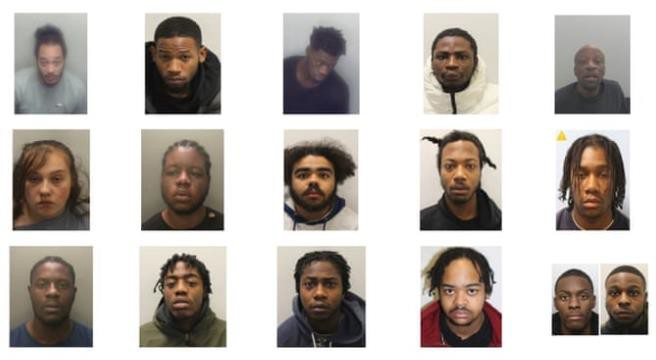
Figure 7 “67” gang members involved in the operation office county line operations in the south east of England. Image obtained from.34

Figure 8 Image displaying the five county lines involved in the jailing of 16 members of the “67” gang. Image recreated on office using data from.34
Over the last five years there has been a significant increasing an related violence. Since 2015, when county lines first emerged as a criminal business model,1 the number of recorded fire arms offences has been on a steady increase and there remains a strong connection to drugs among firearms offences.5 Figure 9 displays the increase in firearms offences across England and Wales over the last five years (April 14 to March 19).
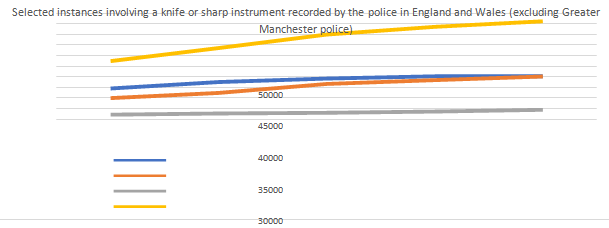
Figure 9 Line graph showing the increase in the number of offences involving firearms over the last five years. Graph recreated on office using data obtained from.35
Across the five year time period from 2015 to2020, offences involving a knife or sharp instrument have also been on the increase. In the year ending March 2020 there was a record number of recorded offences involving knives, the highest since records began.36 Figures 10&11 show the increase in selected instances involving knives as well as the total number of instances.
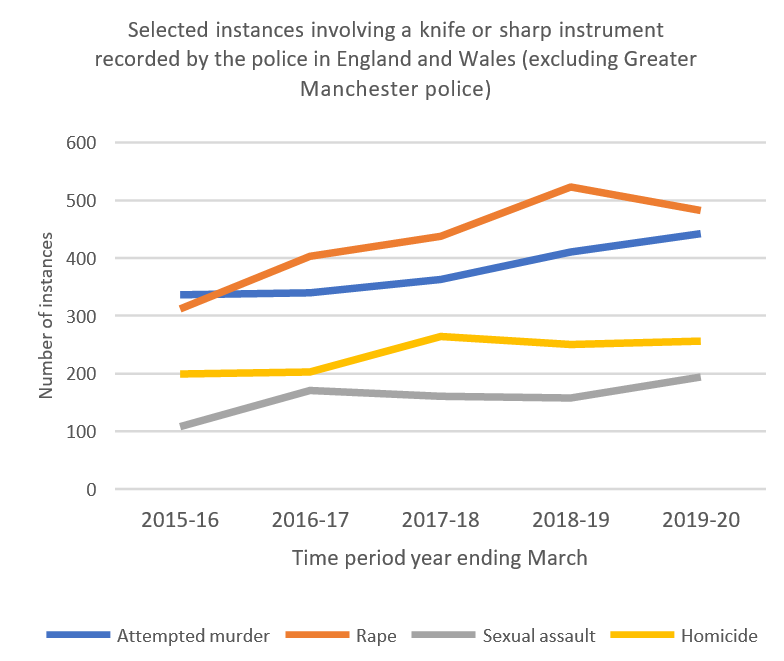
Figure 10 Line graph showing the increase in the recorded offences using a knife or sharp instrument over the last five years. Graph recreated on office using data from.36
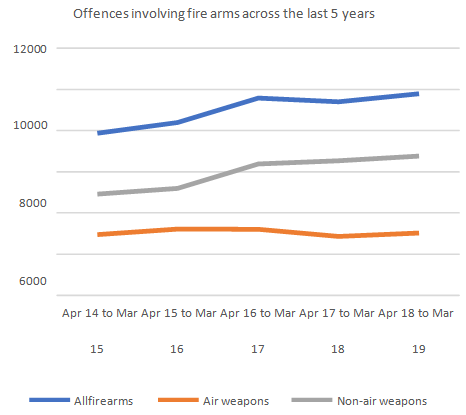
Figure 11 Line graph showing the increase in the recorded offences using a knife or sharp instrument over the last five years. Graph recreated on office using data from.36
Increases in violent crime coincide with the emergence of county lines groups. It is no surprise that there has been an upsurge in violent crime as the number of individuals involved with county lines continues to grow. There remains a strong connection between drugs and violence, with more people committing drugs offences, the number of people involved in violent crime increases as a result.
The increasing number of county lines groups and the increase in gang related violence shows that a nation wide approach from police forces is needed in order to implement preventative measures to not only stop these groups growing larger, but to help put as top to them all together. One example of this is the Hackney Integrated Gangs Unit (HIGU) in London. Which was set up ten years ago with the remit of bringing all the people involved in working in gang crime together. This includes sharing information between police, probation officers, youth offending workers and mentors.37
PC Preston from the metropolitan police states that gang lifestyle is “a difficult lifestyle to get out of once you’re fully entrenched. And actually, what we need to do is say to that young person, ‘we're not going to leave you’”.37 Key factors for why young people are recruited by gangs include close bonds and a sense of belonging. Young people crave someone to look after them. If they have no family or have been in care with no adult providing a positive influence or support, then they seek this from a gang as a family substitute.37 This key feature must be recognized as important for the prevention of recruitment of young people into gangs.
Groups like the HIGU should look to create this sense of family with the young people in their area. For example, Michael, who is 26, was in and out of custody from the age of 13 for drugs offences and robbery. He is now in steady employment and says he owes a lot to his probation worker, stating that she is “like family”. Michael was able to get out of gang involvement through the support of his probation worker and now wants to go into prisons and talk to young people himself.37 Participation of ex-gang members is an important tool in not only the prevention of gang involvement but also helping to provide a route out. The involvement of ex-gang members provides an alternative role model to look up to and guide people on a better life path.
With an increase in the number of county lines groups, there has also been an increase in the approach to tackle this type of criminality. This comes from enforcement of the law and also from safeguarding those who have been exploited. Tackling county lines operations requires a joint approach from police forces due to the way that they cross multiple police borders. A new organization was set up and began operating in September 2018 called the National County Lines Co-ordination Centre (NCLCC), which is jointly led by the NCA and the National Police Chiefs Council (NPCC). The objective of this group is to improve law enforcements ability to get an accurate intelligence and understanding of the problem.6
In 2019 the NCLCC carried out its first intelligence based search and was able to produce over 600arrests and recovered over £200,000 in cash along with a substantial amount of drugs, firearms and other weapon types.38 In addition, approximately 400 vulnerable adults and 600 children were identified and offered safeguarding, protection and support.6 This showed how the multi-agency approach from police force across the UK and key partners such as public health, Department for Education, social care and the charity sector, is extremely important in the fight against county lines.38 Potential victims of trafficking should be referred to the National Referral Mechanism (NRM)38 and 40 people were referred as part of this search.6
The Home Office has also been in talks with transport companies such as uber and private car hire companies to encourage a partnership. These companies are educated to spot the warning signs of county lines and how they can offer a response to this.6 There are various different indicators that point towards vulnerable and young people being criminally exploited. Table 2 details some of the signs that may point towards criminal exploitation.29 Improving the awareness of these indicators with safeguarding agencies, health care professionals, the public and other groups involved in the care of children and vulnerable adults should be apriority for those involved in tackling criminal exploitation. Spotting these signs and ensuring there is a protocol to be followed to escalate concerns, allows young and vulnerable people at risk of gang involvement to be given the correct support.3 This will massively reduce the number of people being exploited by gangs.
|
Indicators of criminal exploitation |
|||||
Frequent missing episodes and being found outside of their home area. |
|||||
Large quantities of drugs of drugs or weapons found on persons. |
|||||
Drugs found inside rectumor vagina. |
|||||
Cash, mobiles, jewellery, haircuts, clothes or trainers that cannot be explained. |
|||||
Injuries or disheveled after returning from a missing episode. |
|||||
Changes in behavior such as being more secretive, isolated from peers and not mixing with normal friend ship groups. |
|||||
Absence from or not engaging properly in school/college/training/work. |
|||||
Disruptive, aggressive, or ho still eat home or school, including use of sexualized language and talk of drugs or violence. |
|||||
Expressing invincibility and that they don’t care what happens to them. |
|||||
High interest in making money. |
|||||
Reports of unknown adult staking them top arties, nightclubs, hotels, unknown people’s |
|||||
|
Houses |
|||||
An increased use of drugs and alcohol. |
|||||
Owning multiple phones and/or sim cards with multiple texts, calls or notifications which is not usual. |
|||||
Possession of keys or cards that provide access to un known premises. |
|||||
Reporting sexual or physical assault, followed by withdrawal of the allegation. |
|||||
Abduction/forced imprisonment. |
|||||
Entering and leaving cars of unknown adults. |
|||||
Self-harm or changes to well-being. |
|||||
Agencies unable to engage. |
|||||
New peer groups and relationships. |
|||||
Parental concerns. |
|||||
Repeated STI’s/pregnancy. |
|||||
Table 2 Indicators of criminal exploitation in young/vulnerable people. Obtained from29
Concerns about children should be reported to a safeguarding organization or referred directly to children’s social care, and involvement of adults with human trafficking should be reported to the NRM.3 These procedures should be constantly evaluated and experiences hared between teams to ensure best practice is followed and improvements in these procedures can be made. Careful thought should be given to which groups need to be targeted. Giving informative talks to schools and other educational settings is useful, even if most of the people in these settings will never encounter problems with organized crime. However, groups that need to be targeted may have fallen out of the education system. Thought should be given as to how these groups can being aged and where they may be found. For example, youth centers and clubs outside of school that offer incentives to young people.
These clubs offer a place to socialize offering games, food and drinks. Agencies should aim to target places where vulnerable people attend to educate and promote awareness. A healthy relationship with the police should been courage in these settings as a way of deterring children from gangs.
Risk of gang involvement can also be reduced by spreading a sense of involvement and promoting healthy relationships through local communities.3 Although this may be a slow process and will not be achieved overnight, or without a radical change in attitude. Building of self-worth and self-esteem should been courage. Midwives and health care professionals can nurture family relationships. Schools, youth centers, social workers and probation workers can teach valuable life skills and educate about the risks of gang involvement and the routes out. Young and vulnerable people need to be supported and society needs to be inclusive of them in order to encourage good life choices and build a positive future.3
It is evident that county lines has had a severe effect on young people, vulnerable adults and the community as a whole. The continual growth in the numbers of these groups has led to an increase in many crime types, as previously discussed. Increasing numbers of young people and vulnerable adults have been exploited and trafficked for drug selling purposes by these gangs. Consequently leading to an increase of illicit drugs available in our communities. Violent crimes involving firearms and knives or sharp instruments have continued to increase with the emergence of county lines. A record high number of 46,265 offences involving a knife or sharp instrument were recorded in the year ending March 2020 and a staggering 4757 hospital episodes involving an assault by a sharp object were recorded in the same period.36 Data for the following year is not yet available, but if these numbers continue to rise then it will un doubt ably put extreme pressure on NHS services. At a time where they are already massively over stretched due to the COVID-19 pandemic.
It is therefore vital that staff involved in the health care of vulnerable people are given the relevant training in order to spot the signs of county line involvement. This will enable them to identify and intervene as soon as possible to prevent harm to that person. The financial consequences of county lines activity on the overall national economy cannot be ignored or underestimated. A global approach into funding, including all involved agencies, is vital for the implementation of these methods and requires political will and commitment. It is clear that more international cooperation is needed to combat this situation. Prevention methods need to be readily available nation wide across the UK. Services currently available are concentrated in big cities like London, Liver pool and Birmingham. For these prevention methods to have an effect they need to be available in all areas, highlighted by the fact that all police forces in the UK have reported problems with county lines. The UK’s problem will only continue to grow if the right guidance and preventative methods are not enforced. An increased awareness within the public and more media coverage will result in increased police intelligence and better methods for combating the issue. The number of active lines will decrease if young people and vulnerable adults can be prevented from becoming involved in these groups. More importantly these people will be protected and exposure to exploitation as well as mental and physical harm will be avoided.
None.
The authors declare that they have no known competing financial interests or personal relationships that could have appeared to influence the work reported on this paper.

©2021 O’Hagan, et al. This is an open access article distributed under the terms of the, which permits unrestricted use, distribution, and build upon your work non-commercially.